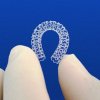Amaranth Medical, a company with offices in Mountain View, CA and Singapore, has developed a bioresorbable drug-eluting scaffold that looks and works much like a stent, but slowly disappears over time after implantation. The company is now testing the second generation of its FORTITUDE Sirolimus-Eluting Bioresorbable Scaffold in a clinical trial being conducted at multiple Colombian hospitals.
The device was designed to provide a similar outward pressure on vessel walls as the company’s bare bioresorbable scaffold, but to also release sirolimus (aka rapamycin) immunosuppressant to prevent restenosis of the treated vessel. Initial results of the study have shown that by using optical coherence tomography to measure the inner diameter of the vessel around the implantation site, the scaffold maintained its shape and held back the vessel walls. Complete 12 month follow up results were also presented at the 2014 Transcatheter Cardiovascular Therapeutics (TCT) Meeting.
From the announcement:
This study met its primary endpoint of six-month incidence of target vessel failure with no incidents of stent thrombosis or mechanical failure. Importantly, late lumen loss, as confirmed by an independent core lab, was shown to be comparable to that of bare metal stents.
Juan F. Granada, M.D., executive director and chief innovation officer of the CRF-Skirball Center for Innovation (SCI) and primary investigator of the Amaranth clinical program, added, “We are encouraged by the positive results from MEND-I, especially in terms of the biocompatibility profile of the polymer. It is notable that FORTITUDE appears equivalent in its biological response to metal stents, which represents a significant leap forward in the advancement of the science and processing technology of these polymers. Further, while the FORTITUDE Sirolimus-Eluting Bioresorbable Scaffold is still in early stages of enrollment, it appears to have similar mechanical behavior but enhanced deliverability compared to the first-generation bare scaffold.”
source:Amaranth Medical
2nd Generation FORTITUDE Sirolimus-Eluting Bioresorbable Scaffold

